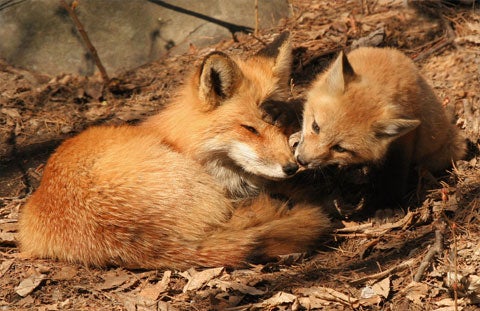April Overall and Sarah Jones

In a wild world that condones roaming eyes, pairs that stick it out for the long haul are a dime a dozen. They might not send Valentine’s Day cards, dine by candlelight or listen to Barry White to set the mood, but these couples know how to keep the love alive.
I Chew-se You
Beavers (Castor canadensis) take advantage of the blustery months of January and February by cozying up together. These critters are very family oriented; they search out one “true” mate and make a life together—building a home and having a family. The female is always the central figure of the family and is usually the one calling the shots and establishing the dam, which will become her home for life. Even if she loses her mate, she and her young will stay with the home until she meets another mate the following breeding season. Young stay with their parents between two and three years and help with chores around the dam, such as cutting trees and patching leaks, in their second season. They will remain in the dam in which they were born until they are ready to brave the world and find a mate to call their own.
Let’s Give Them Something to Honk About
Spring fever takes over the Canada goose (Branta canadensis) in April and May and once they find “the one,” they stick it out for their entire lives. Moreover, they only search out new mates if their own has been killed. On average, the female lays five to seven eggs and incubates them for over three weeks, while the male stands guard a few metres away. He will return to the nest should there be any threat to his partner or his young, or should the female need to leave the nest for a sip of water or a bath. When the goslings hatch, they stay close to their parents for an entire year and return to their breeding grounds with them after their first migration. The pair will nest, raise and defend their young together season after season.
Red Hot Love
While desire gets the best of the red fox (Vulpes vulpes) every so often, this animal is primarily red hot for its mate only, breeding between December and March. Once they scout out a dreamy locale for a den (or two)—bordering on a forest, at the edge of a serene stream bank—they hunker down to raise their family. When the cubs are born, between March and May, the female fox (called a vixen) will keep the male (called a dog) at bay until the young are able to open their eyes. The dog will continue to put dinner on the table until the young begin to crawl and the vixen can get out and hunt for the family herself. When the cubs are one month old, both parents bring small game back to them to toy with and to encourage their hunting instincts. When the young head off on their own, the couple will come together again, year after year, for breeding and denning.
Bedroom Eyes
The dark-eyed junco (Junco hyemalis), found across all Canadian provinces, is considered a socially monogamous animal. Essentially, this bird may flit back and forth to cozy up with neighbouring birds but will always settle down with its mate. Though occasionally unfaithful, the couples are a very efficient and loyal team. They defend their home and young together, and both males and females participate in the raising the young. The nest is typically built on the ground, where it is concealed under rocks, logs or on sloping banks. More than one clutch can be laid in one season, with larger clutches in early season and smaller clutches in late season. The prairie vole (Microtus ochrogaster) has become the poster animal for monogamy. These small rodents, which habitat the grasslands of Canada, create an unbreakable bond with one mate and are often attached at the hip until one or the other dies. Many scientists have studied these mammals, hoping to learn the secret to monogamy and have found the chemical oxytocin to be the key to it all. A dose of oxytocin can be sparked through intimate moments—touching, caressing and, of course, making whoopee—and ramps up the bonding process between two mammals. The end result? A stable, long-lasting bond.
You Give Me a High
The prairie vole (Microtus ochrogaster) has become the poster animal for monogamy. These small rodents, which habitat the grasslands of Canada, create an unbreakable bond with one mate and are often attached at the hip until one or the other dies. Many scientists have studied these mammals, hoping to learn the secret to monogamy and have found the chemical, oxytocin, to be the key to it all. A dose of oxytocin can be sparked through intimate moments— – touching, caressing and, of course, making whoopee— and ramps up the bonding process between two mammals. The end result? A stable, long-lasting bond.
Grand Gestures
Having found its mate earlier, the greater snow goose (Chen caerulescens atlantica) arrives in the Canadian High Arctic in early June, ready to shack up. The female gets busy during the first couple of weeks, choosing a site and building her nest with dry vegetation she finds around the nesting area, while the male kicks up his feet close by. Once she’s satisfied, she hunkers down and lays one egg every 36 hours—laying up to five eggs in total. The female will only leave the nest to grab some grub, and the male will step in to guard the eggs. Once the chicks hatch, both parents will stay close to home and nurture them for a year.






